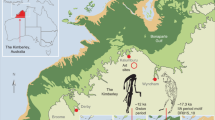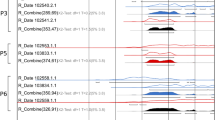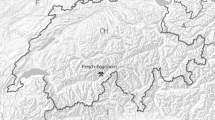Abstract
The Jinmium rock shelter is located in the Kimberley region of northern Australia. Claims for ancient rock art and an early human presence at this site1 were based on thermoluminescence ages of 50–75 thousand years (kyr) for quartz sands associated with buried circular engravings (pecked cupules) and on thermoluminescence ages of 116–176 kyr for the underlying artefact-bearing deposits. Here we report substantially younger optical ages for quartz sand, and ages based on measurements of radioactive carbon in charcoal fragments, from the occupation deposit. Using conventional (multiple-grain) optical dating methods, we estimate that the base of the deposit is 22 kyr. However, dating of individual grains shows that some have been buried more recently. The single-grain optical ages indicate that the Jinmium deposit is younger than 10 kyr. This result is in agreement with the late-Holocene ages obtained for the upper two-thirds of the deposit from radiocarbon measurements. We suggest that some grains have older optical ages because they receivedinsufficient exposure to sunlight before burial. The presence of such grains in a sample will cause age overestimates using multiple-grain methods, whether using thermoluminescence or optical dating.
This is a preview of subscription content, access via your institution
Access options
Subscribe to this journal
Receive 51 print issues and online access
$199.00 per year
only $3.90 per issue
Buy this article
- Purchase on Springer Link
- Instant access to full article PDF
Prices may be subject to local taxes which are calculated during checkout


Similar content being viewed by others
References
Fullagar, R. L. K., Price, D. M. & Head, L. M. Early human occupation of northern Australia: archaeology and thermoluminescence dating of Jinmium rock-shelter, Northern Territory. Antiquity 70, 751–773 (1996).
Bird, M. I. & Gröcke, D. R. Determination of the abundance and carbon isotope composition of elemental carbon in sediments. Geochim. Cosmochim. Acta 61, 3413–3423 (1997).
Tuniz, C. et al. Research and measurement program at the ANTARES AMS facility. Nucl. Instrum. Methods Phys. Res. B 123, 73–78 (1997).
David, B., Roberts, R., Tuniz, C., Jones, R. & Head, J. New optical and radiocarbon dates from Ngarrabullgan Cave, a Pleistocene archaeological site in Australia: implications for the comparability of time clocks and for the human colonization of Australia. Antiquity 71, 183–188 (1997).
Huntley, D. J., Godfrey-Smith, D. I. & Thewalt, M. L. W. Optical dating of sediments. Nature 313, 105–107 (1985).
Aitken, M. J. Optical dating: a non-specialist review. Quat. Sci. Rev. 13, 503–508 (1994).
Duller, G. A. T. Recent developments in luminescence dating of Quaternary sediments. Prog. Phys. Geogr. 20, 127–145 (1996).
Aitken, M. J. An Introduction to Optical Dating (Oxford Univ. Press, Oxford, (1998)).
Godfrey-Smith, D. I., Huntley, D. J. & Chen, W.-H. Optical dating studies of quartz and feldspar sediment extracts. Quat. Sci. Rev. 7, 373–380 (1988).
Lamothe, M., Balescu, S. & Auclair, M. Natural IRSL intensities and apparent luminescence ages of single feldspar grains extracted from partially bleached sediments. Radiat. Meas. 23, 555–561 (1994).
Lamothe, M. & Auclair, M. Assessing the datability of young sediments by IRSL using an intrinsic laboratory protocol. Radiat. Meas. 27, 107–117 (1997).
Roberts, R. et al. Luminescence dating of rock art and past environments using mud-wasp nests in northern Australia. Nature 387, 696–699 (1997).
Murray, A. S. & Roberts, R. G. Determining the burial time of single grains of quartz using optically stimulated luminescence. Earth Planet. Sci. Lett. 152, 163–180 (1997).
Murray, A. S. & Roberts, R. G. Measurement of the equivalent dose in quartz using a regenerative-dose single-aliquot protocol. Radiat. Meas. (in the press).
Murray, A. S. & Mejdahl, V. Comparison of regenerative-dose single-aliquot and multiple-aliquot (SARA) protocols using heated quartz from archaeological sites. Quat. Sci. Rev. (submitted).
Galbraith, R. F. & Laslett, G. M. Statistical models for mixed fission track ages. Radiat. Meas. 21, 459–470 (1993).
Roberts, R. G. Luminescence dating in archaeology: from origins to optical. Radiat. Meas. 27, 819–892 (1997).
Spooner, N. A. Human occupation at Jinmium, northern Australia: 116,000 years ago or much less? Antiquity 72, 173–178 (1998).
Roberts, R. G., Jones, R. & Smith, M. A. Thermoluminescence dating of a 50,000 year-old human occupation site in northern Australia. Nature 345, 153–156 (1990).
Roberts, R. G. et al. The human colonisation of Australia: optical dates of 53,000 and 60,000 years bracket human arrival at Deaf Adder Gorge, Northern Territory. Quat. Sci. Rev. 13, 575–583 (1994).
1. Huntley, D. J. & Clague, J. J. Optical dating of tsunami-laid sands. Quat. Res. 46, 127–140 (1996).
Murray, A. S., Marten, R., Johnston, A. & Martin, P. Analysis for naturally occurring radionuclides at environmental concentrations by gamma spectrometry. J. Radioanal. Nucl. Chem. Articles 115, 263–288 (1987).
Prescott, J. R. & Hutton, J. T. Cosmic ray contributions to dose rates for luminescence and ESR dating: large depths and long-term time variations. Radiat. Meas. 23, 497–500 (1994).
Mejdahl, V. Thermoluminescence dating: beta-dose attenuation in quartz grains. Archaeometry 21, 61–72 (1979).
Rees-Jones, J. & Tite, M. S. Optical dating results for British archaeological sediments. Archaeometry 39, 177–187 (1997).
Stuiver, M. & Reimer, P. J. Extended 14C data base and revised CALIB 3.0 14C age calibration program. Radiocarbon 35, 215–230 (1993).
Nambi, K. S. V. & Aitken, M. J. Annual dose conversion factors for TL and ESR dating. Archaeometry 28, 202–205 (1986).
Olley, J. M., Murray, A. & Roberts, R. G. The effects of disequilibria in the uranium and thorium decay chains on burial dose rates in fluvial sediments. Quat. Sci. Rev. 15, 751–760 (1996).
Galbraith, R. F. Graphical display of estimates having differing standard errors. Technometrics 30, 271–281 (1988).
Galbraith, R. F. The radial plot: graphical assessment of spread in ages. Nucl. Tracks Radiat. Meas. 17, 207–214 (1990).
Acknowledgements
We thank the traditional owners and custodians (B. Simon, P. Carlton, others from Marralam, and the local Mirriuwung–Gajerrong people), the Waringarri Aboriginal Corporation, the Conservation Commission of the Northern Territory, the Aboriginal Areas Protection Authority, and the managers of Spirit Hills station for permission to undertake this study; and other members of the ANSTO AMS team (in particular D. Fink, M. Hotchkis and A. Smith) for their contribution, L. Frick and R. Maas for ICP-MS analyses, N. Minch for help with Fig. 1 , D. Huntley for his dose-intercept program, and M.Aitken, D. Huntley, O. Lian, A. Murray and A. Wintle for comments. The Australian Institute of Aboriginal and Torres Strait Islander Studies, Australian National University and University of Wollongong funded the 1995 fieldwork, and the Australian Institute of Nuclear Science and Engineering funded the 1993 OZ sample AMS determinations. We acknowledge the support of the Australian Research Council through Queen Elizabeth II Fellowships to R.R. and M.B. and a Research Fellowship to R.F., and support from CSIRO Mathematical and Information Sciences (R.G.).
Author information
Authors and Affiliations
Corresponding author
Rights and permissions
About this article
Cite this article
Roberts, R., Bird, M., Olley, J. et al. Optical and radiocarbon dating at Jinmium rock shelter in northern Australia. Nature 393, 358–362 (1998). https://doi.org/10.1038/30718
Received:
Accepted:
Issue Date:
DOI: https://doi.org/10.1038/30718
This article is cited by
-
The effect of the introduction of livestock on the erosion of alpine soils: a comparison of five dating techniques applied to sediments of the Australian alpine Blue Lake
Journal of Paleolimnology (2023)
-
Optically stimulated luminescence dating using quartz
Nature Reviews Methods Primers (2021)
-
Holocene sea-level history and tectonic implications derived from luminescence dating of raised beaches in Terra Nova Bay, Antarctica
Geosciences Journal (2021)
-
In-silico analysis and expression profiling implicate diverse role of EPSPS family genes in regulating developmental and metabolic processes
BMC Research Notes (2014)
-
Comprehensive database of Chorismate synthase enzyme from shikimate pathway in pathogenic bacteria
BMC Pharmacology and Toxicology (2013)
Comments
By submitting a comment you agree to abide by our Terms and Community Guidelines. If you find something abusive or that does not comply with our terms or guidelines please flag it as inappropriate.



